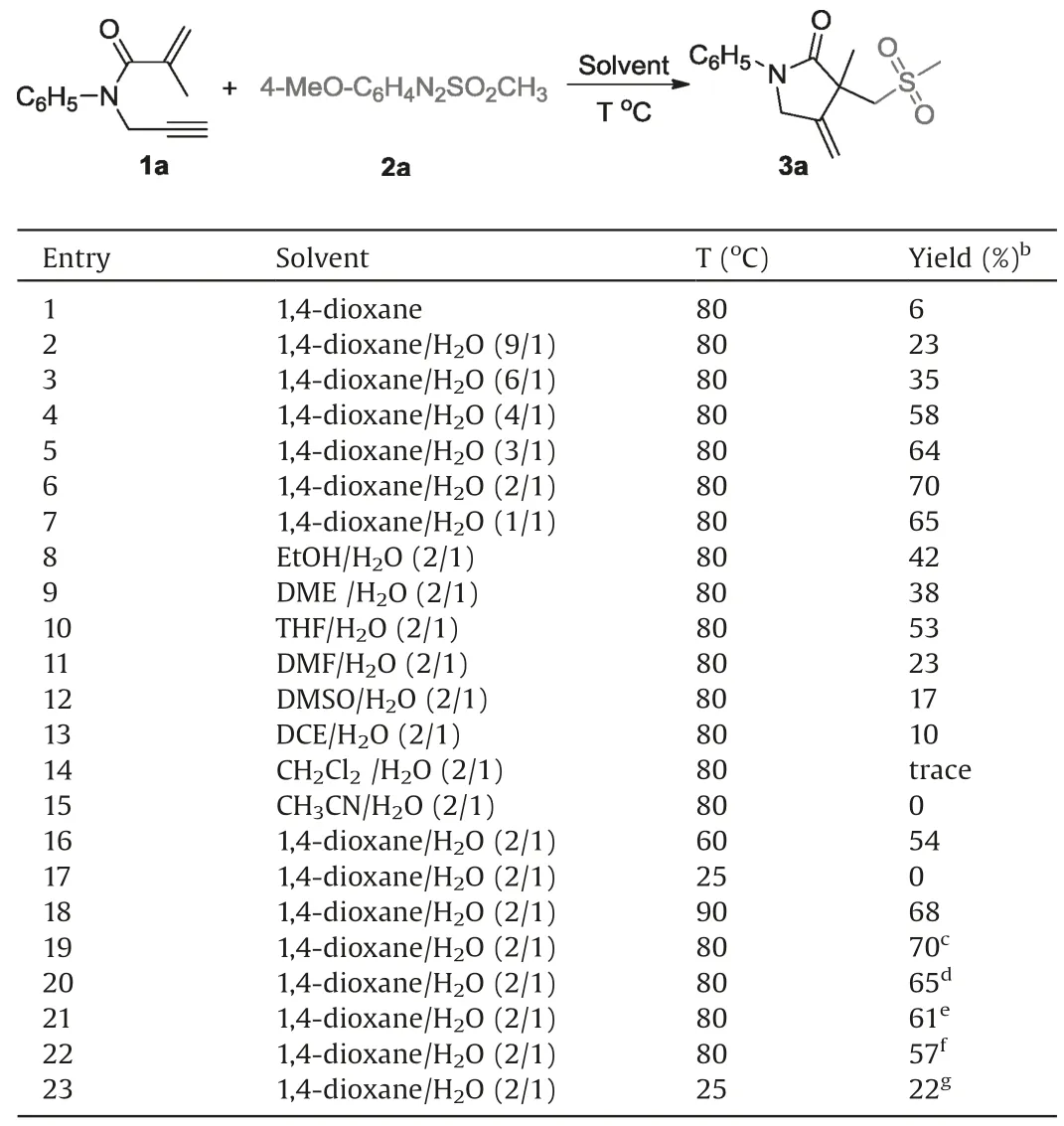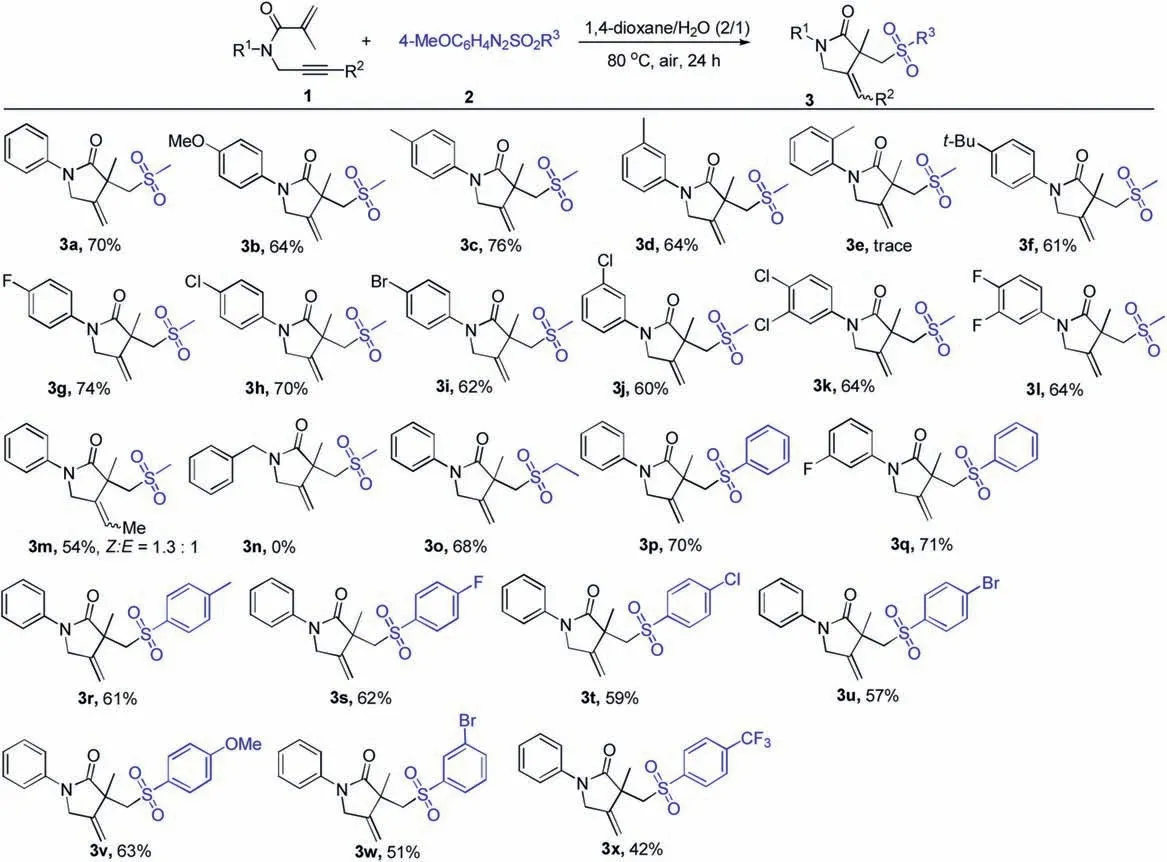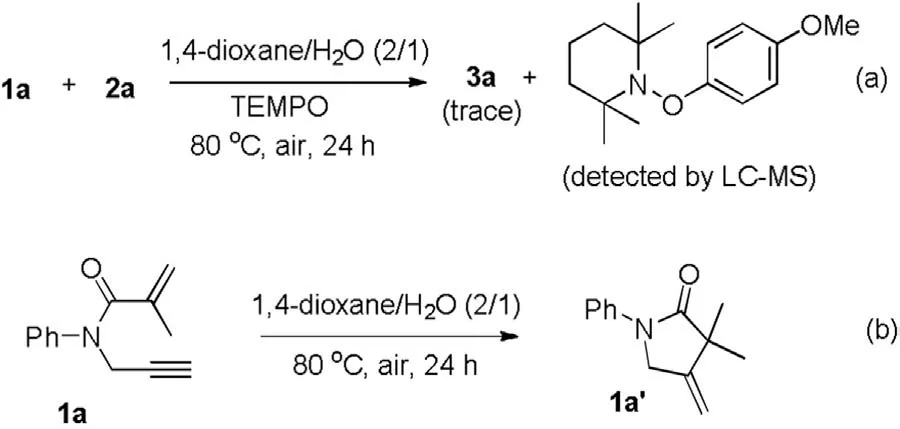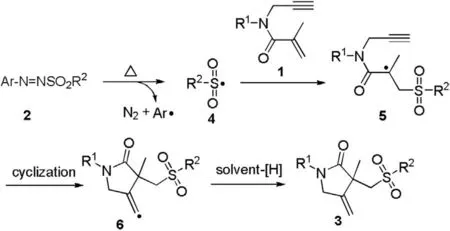Catalyst-and additive-free selective sulfonylation/cyclization of 1,6-enynes with arylazo sulfones leading to sulfonylated γ-butyrolactams
2021-04-02QishunLiuYufenLvRuishengLiuXiohuiZhoJiwenWngWeiWei
Qishun Liu,Yufen Lv,Ruisheng Liu,Xiohui Zho**,Jiwen Wng,Wei Wei,*
a School of Chemistry and Chemical Engineering, Qufu Normal University, Qufu 273165, China
b Qinghai Provincial Key Laboratory of Tibetan Medicine Research and Key Laboratory of Tibetan Medicine Research, Northwest Institute of Plateau Biology,Chinese Academy of Sciences, Qinghai 810008, China
c College of Chemistry and Chemical Engineering, Shenyang Normal University, Shenyang 110034, China
ABSTRACTA convenient and regioselective sulfonylation/cyclization of 1,6-enynes with arylazo sulfones has been developed to access a series of sulfonylated γ-butyrolactams.The present reaction could be efficiently conducted under catalyst-and additive-free conditions,in which C--S and C--C bonds were selectively constructed in one-pot procedure.
Keywords:Catalyst-free Arylazo sulfones 1,6-Enynes Sulfonylated γ-butyrolactams
Sulfone-containing compounds are frequently found in pharmacologically active compounds, natural products, and materials [1].Furthermore, they can also be employed as important intermediates in various organic transformations to access a series of useful molecules [2].Consequently, the introduction of sulfone functionality into organic framework has attracted considerable synthetic pursuit of chemists because of their interesting biological activities and versatile synthetic applications[3].During the past decades,a number of sulfonylating agents such as sulfonyl chlorides [4], sulfonyl hydrazides [5],sulfinates[6],sulfinic acids[7],thiophenols[8],sulfonyl cyanides[9], sulfonyl selenides [10] and SO2surrogates [11] have been developed for the construction of organic sulfones.Nevertheless,most of these sulfonylation reactions usually require the use of catalysts or a stoichiometric amount of oxidants, or suffer from complex reaction conditions.It is still highly desirable to develop new strategies to construct sulfone-containing compounds from simple sulfonylating agents under mild conditions.
Arylazo sulfones are colored and bench stable compounds,which could generate aryl radical and sulfonyl radical along with the release of N2through the homolytic cleavage of C--N and S--N bonds under visible-light irradiation or heating conditions [12].Generally, arylazo sulfones are utilized as arylating reagents in photoinduced reactions in the absence of photocatalyst [13].Recently, arylazo sulfones have alternatively emerged as sulfonylating agents for constructing sulfone-containing compounds[14].In 2019,our group reported oxysulfonylation of alkenes or alkynes with arylazo sulfones and dioxygen leading to β-oxo sulfones under visible-light irradiation conditions (Scheme 1a) [14a,b].In 2020, Yadav and co-workers also described an efficient visiblelight mediated decarboxylative sulfonylation of cinnamic acids and arylazo sulfones for the synthesis of(E)-vinyl sulfones(Scheme 1b)[14c].As our ongoing interest in sulfonylation reactions [15],herein, we wish to present a catalyst-and light-free selective sulfonylation/cyclization of 1,6-enynes with arylazo sulfones to synthesize sulfonated γ-butyrolactams under simple heating conditions (Scheme 1c).
The cyclization of 1,n-enynes has become as a powerful protocol for the construction of various important heterocycles such as quinolines,pyrroles,pyridines,furans,indoles and pyrans in terms of its step-economy and high reaction efficiency [16-18].γ-Butyrolactam is the core structure of a large number of natural and biologically active compounds, which covered a wide spectrum of biological activities [19].Recently, some functionalized γ-butyrolactams have been elegantly synthesized through the radical 1,6-enyne cyclization strategies under light or strong oxidant mediated conditions [20].The present reaction, which simply utilizes arylazo sulfones as sulfonylating agents, offers a convenient and regioselective approach to access various sulfonylated γ-butyrolactams under mild and catalyst-free conditions.

Scheme 1.Sulfonylation reactions using arylazo sulfones.
At the beginning of the experiment, the model reaction of Nphenyl-N-(prop-2-yn-1-yl)methacrylamide (1a) with 4-methoxyphenylazo mesylate (2a) was chosen to test the optimized reaction conditions.The product 3a was only isolated in 6% yield when the model reaction was conducted in 1,4-dioxane at 80°C(Table 1, entry 1).To our delight, the yield of 3a was largely increased when water was added in this reaction system(Table 1,entries 2-6).The highest yield of 3a(70%)was obtained when theratio of 1,4-dioxane and water was 2:1(Table 1,entry 6).The yield would be slightly decreased if we continued to increase the amount of water (Table 1, entry 7).Next, various mixed solvents with organic solvent and water (2/1) were investigated (Table 1,entries 8-15).Generally, low to moderate yields were observed when the reaction was carried out in the mixture of EtOH, DME,THF, DMF, DMSO, or DCE with H2O (2/1).Only a trace amount of product 3a was detected when the reaction was performed in CH2Cl2/H2O(2/1).None of the product was observed in CH3CN/H2O(Table 1, entry 15).The decrease of reaction temperature would lead to lower reaction efficiency.No transformation was observed when the reaction was conducted at room temperature (Table 1,entry 17).The reaction was not improved when the reaction temperature was increased to 90°C (Table 1, entry 18).Furthermore,product 3a was still obtained in good yield when the reaction was carried out under nitrogen atmosphere (Table 1, entry 19).Moreover,the use of other arylazo mesylates(4-methylphenylazo mesylate, 4-fluorophenylazo mesylate or 4-chlorophenylazo mesylate) to replace 4-methoxyphenylazo mesylate also gave the desired product 3a,but lower reaction efficiency was observed(Table 1,entries 20-22).Moreover,when the reaction was carried out under irradiation with 3 W Blue LED lamps,the corresponding product 3a was obtained in 22% yield (Table 1, entry 23).

Table 1 Screening of the reaction conditions.a
Under the optimized conditions, the scope and limitation of various 1,6-enyne derivatives and arylazo sulfones were further examined (Scheme 2).Generally, a series of 1,6-enynes with both electron-donating and electron-withdrawing groups on the Naromatic ring could undergo the reaction efficiently to produce the desired products (3b-3l) in moderate to good yields.Notably,halogen substituents such as F,Cl and Br groups were all tolerated in this reaction system, which could be used for the further modification via coupling reactions.It was found that the reaction efficiency was greatly affected by the steric hindrance of substituent on the aromatic ring, and only a trace amount of product 3e was detected when ortho-methyl N-aromatic ring substrate was employed in this system.Unfortunately, when Nalkyl substituted 1,6-enyne such as N-benzyl-N-(prop-2-ynyl)methacrylamide was tested in the present reaction, none of the desired product 3n was detected.It should be noted that internal alkyne such as N-(but-2-yn-1-yl)-N-phenylmethacrylamide was suitable for this reaction, affording the product 3m in moderate yield.Then,the scope of different arylazo sulfones was investigated.Arylazo alkylsulfone (i.e., 4-methoxyphenylazo ethyl sulfone)could also be utilized in this system to afford the corresponding product 3o in 68%yield.Moreover,a variety of arylazo arylsulfones bearing an electron-donating (methyl and methoxy) or an electron-withdrawing group (fluoro, chloro, bromo and trifluoromethyl) on the aryl rings were suitable substrates, and the corresponding products (3r-3x) were obtained in moderate to good yields.
To investigate the possible reaction mechanism, two control experiments were carried out.When radical scavenger TEMPO(2,2,6,6-tetramethyl-1-piperidinyloxy) was added in the model reaction system, the transformation was extremely inhibited and aryl-TEMPO adduct was observed by LC-MS.This result suggested that a radical process might be involved in the present reaction(Scheme 3a).Furthermore, the cyclization product 1a' was not generated from 1a under standard conditions in the absence of 4-methoxyphenylazo mesylate (2a) (Scheme 3b), suggesting that this cascade cyclization was triggered by in situ generated sulfonyl radical.
Based on the above experimental results and previous reports[4,7,8,13,14], a possible reaction pathway was proposed as demonstrated in Scheme 4.Initially, the homolysis of N-S bond of arylazo sulfone 2 generated sulfonyl radical 4 and aryl radical along with the release of N2under heating conditions.

Scheme 2.Substrate scope.Reaction condition: 1 (0.1 mmol), 2 (0.25 mmol),1,4-dioxane/H2O (2/1, 2 mL), 80°C, 24 h.Isolated yields based on 1.

Scheme 3.Control experiments.

Scheme 4.Possible reaction pathway.
In summary, a convenient and efficient method has been developed for the construction of sulfonylated γ-butyrolactams through the regioselective sulfonylation/cyclization of 1,6-enynes with arylazo sulfones.The present transformation could be achieved under catalyst-and additive-free conditions via the sequential formation of C--S and C--C bonds.This protocol simply utilizes arylazo sulfones as sulfonylating agents offering a highly attractive routine to synthesize sulfonylated γ-butyrolactams,which is expected to exhibit potential application in synthetic chemistry.
Declaration of competing interest
The authors report no declarations of interest.
Acknowledgments
This work was supported by the International Cooperation Project of Qinghai Province (No.2018-HZ-806), the Youth Innovation and Technology Project of Higher School in Shandong Province (No.2019KJC021), the Natural Science Foundation of Shandong Province (No.ZR2018MB009), the Qinghai Key Laboratory of Tibetan Medicine Research(No.2017-ZJ-Y11) and CAS “Light of West China” Program 2018, and Entrepreneurship Training Program for College Students (No.201910049).Subsequently, the selective addition of sulfonyl radical 4 to C=C bond gave alkyl radical 5, which further underwent the intramolecular cyclization with the C--C triple bond to give the vinyl radical 6.Finally, the abstraction of a hydrogen from the solvent would produce the desired product 3.
Appendix A.Supplementary data
Supplementarymaterialrelatedtothisarticlecanbefound,inthe online version,at doi:https://doi.org/10.1016/j.cclet.2020.11.059.
杂志排行
Chinese Chemical Letters的其它文章
- Diverse synthesis of the C ring fragment of bryostatins via Zn/Cu-promoted conjugate addition of α-hydroxy iodide with enone
- Directly conversion the biomass-waste to Si/C composite anode materials for advanced lithium ion batteries
- Mechanism and selectivity of copper-catalyzed borocyanation of 1-aryl-1,3-butadienes: A computational study
- Recent advances in the improvement of g-C3N4 based photocatalytic materials
- In-situ electro-deposition synthesis of MnOx-NiCo2O4 monolithic catalyst with rich phase interfaces
- Aconapelsulfonines A and B, seco C20-diterpenoid alkaloids deriving via Criegee rearrangements of napelline skeleton from Aconitum carmichaelii
